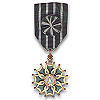Ordre des Arts et des Lettres
| Order of Arts and Letters | |
|---|---|
  Insignia of an Officier and a Chevalier | |
| Native name | |
| French | Ordre des Arts et des Lettres[1] |
| Type | Order of merit with 3 degrees: Commandeur (Commander) Officier (Officer) Chevalier (Knight) |
| Awarded for | Significant contribution to the enrichment of the French cultural inheritance |
| Presented by | French Minister of Culture |
| Status | Active |
| Established | 2 May 1957 |
| Website | http://www.culture.gouv.fr/culture/artsetlettres/, https://www.culture.gouv.fr/Nous-connaitre/Organisation-du-ministere/Conseil-de-l-Ordre-des-Arts-et-des-Lettres |
Commandeur Officier Chevalier Ribbon bars of the Order | |
| Precedence | |
| Next (higher) | Ordre du Mérite Maritime |
| Next (lower) | Médaille des Évadés |
The Order of Arts and Letters[2][3][4][5][6][7] (French: Ordre des Arts et des Lettres[8][9][10]) is an order of France established on 2 May 1957 by the Minister of Culture. Its supplementary status to the Ordre national du Mérite was confirmed by President Charles de Gaulle in 1963. Its purpose is the recognition of significant contributions to the arts, literature, or the propagation of these fields.
Its origin is attributed to the Order of Saint Michael (established 1 August 1469), as acknowledged by French government sources.[1][11][12]
Background
To be considered for the award, French government guidelines stipulate that citizens of France must be at least thirty years old, respect French civil law, and must have "significantly contributed to the enrichment of the French cultural inheritance".
Membership is not, however, limited to French nationals; recipients include numerous foreign luminaries. Foreign recipients are admitted into the Order "without condition of age".
The Order has three grades:
- Commandeur (Commander) — medallion worn on a necklet; up to 20 recipients a year
- Officier (Officer) — medallion worn on a ribbon with rosette on left breast; up to 60 recipients a year
- Chevalier (Knight) — medallion worn on a ribbon on left breast; up to 200 recipients a year
The médaille (medallion) of the Order is an eight-pointed, green-enameled asterisk, in gilt for Commanders and Officers and in silver for Knights; the obverse central disc has the letters "A" and "L" on a white-enameled background, surrounded by a golden ring emblazoned with the phrase République Française. The reverse central disc features the head of Marianne on a golden background, surrounded by a golden ring bearing the words Ordre des Arts et des Lettres. The Commander's badge is topped by a gilt twisted ring.
The ribbon of the Order is green with four white stripes.
Members of the Order

According to the statutes of the Order, French citizens must wait a minimum of 5 years before they are eligible to be upgraded from Chevalier to Officier, or Officier to Commandeur, and must have displayed additional meritorious deeds than just those that originally made them a Chevalier. However, in the statutes, there is a clause saying "Les Officiers et les Commandeurs de la Légion d'honneur peuvent être directement promus à un grade équivalent dans l'Ordre des Arts et des Lettres". (Translation: "The officers and commanders of the Legion of Honour can be promoted directly to an equivalent grade in the Order of Arts and Letters".) This means that if someone were to be made Officier of the Legion of Honour, then the next year, that person could be directly made Officier of the Order of Arts and Letters and bypass a nomination as a knight and the five-year rule.
See also
- Ribbons of the French military and civil awards
- Ordre des arts et des lettres du Québec, a Quebec order based in part on the Ordre des Arts et des Lettres
References
- ^ a b "Conseil de l'Ordre des Arts et des Lettres" [Council of the Order of Arts and Letters]. Ministère de la Culture (in French). Archived from the original on 9 November 2018. Retrieved 21 August 2022.
- ^ Keslassy, Elsa (18 January 2016). "Michael Keaton Gets France's Order of Arts and Letters Honor". Variety.
- ^ "Quebec filmmaker Xavier Dolan joins France's Order of Arts and Letters". CTV News. 27 November 2019.
- ^ "Art historian honoured by French Government". University of Edinburgh. 10 May 2022.
- ^ Richford, Rhonda (17 July 2013). "Bono Awarded France's Highest Honor for Artists". Billboard.
- ^ "Associate Provost and Director of Columbia University Press Jennifer Crewe receives the Award of Chevalier of the Order of Arts and Letters from the Cultural Services of the French Embassy in New York". Columbia University Press. 16 April 2024.
- ^ Haring, Bruce (27 July 2024). "Tom Cruise Awarded Knight Of Arts & Letters By France". Deadline Hollywood.
- ^ "Appointment in the Order of Arts and Letters". Ministry of Culture. Retrieved 12 October 2024.
- ^ Flood, Allison (3 March 2021). "Edna O'Brien to receive France's highest honour for the arts". The Guardian.
- ^ Leitch, Luke (3 March 2024). "Saturday Knight in Paris: Simon Porte Jacquemus Named Chevalier de l'Ordre des Arts et des Lettres". [[Vogue (magazine)|]].
- ^ Archives de FranceArchived 2013-04-16 at the Wayback Machine
- ^ Mémodoc
External links
- "Nominations dans l'Ordre des Arts et Lettres" (in French). Ministry of Culture (France). 2007. Archived from the original on 10 February 2009. Retrieved 6 February 2009.
